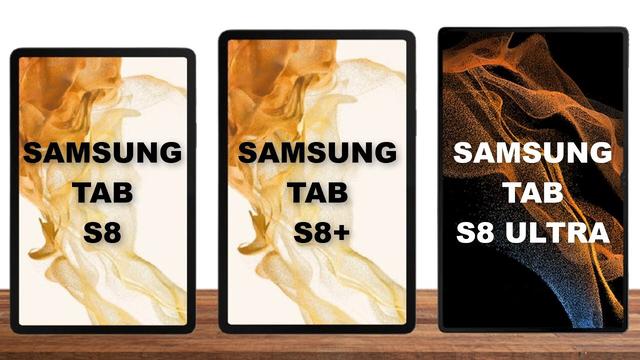(Pocket-lint) - Samsung's 2022 flagship tablets have been announced in the form of the Tab S8. But there's also the S8+ and S8 Ultra models within the line-up, so how does each of the trio's feature set differ - and is it more than just screen size differences?
squirrel_widget_6561786
Screen
The principal difference between each tablet is its screen size: the S8 is the smallest, at 11-inches; the S8+ is the middle size, at 12.4-inches; the S8 Ultra tops the three with its 14.6-inch display. Resolution increases per size, as you can see in the specification above, ensuring a crisp view irrelevant of which option you pick.
That's not all, though, as the 'entry' S8 model features an LCD display, while the S8+ and S8 Ultra feature AMOLED panels - the latter ought to offer a wider colour spectrum, deeper blacks and cleaner whites - and all panels deliver a refresh rate of up to 120Hz (double that of the standard, meaning smoother visuals for scrolling, gaming, and the like).
Design
Relative to the screen size, of course, are slight design shifts between the three slates. The S8, being the smallest tablet of the trio, is actually the thickest. As the screen size expands, so the physical thickness dwindles by some points of a millimetre. The S8 Plus is particularly slender, at just 5.5mm - far slimmer than current flagship phones.
There are Wi-Fi only and 5G versions of each device, the choice being yours. The addition of mobile connectivity obviously requires more components and, therefore, the weight increase is pushed up - but only to a minor degree.
All three tablets feature fingerprint scanning for sign-in and payment options, but that's a side-mounted one for the S8 - the S8+ and Ultra both feature under-displayer scanners as part and parcel of the AMOLED panel deal.

Oddly enough the S8 Ultra is only available in a 'Graphite' finish (as are the other two tablets), with the silver and pink options only available on the smaller-scale slates.
squirrel_widget_6561844
Hardware
In terms of what's under the hood, there's top-tier hardware only. Unlike the S22 series of phones, however, it appears that all the tablets will get Qualcomm hardware (certainly the European devices we saw didn't have Exynos anyway).
In terms of longevity you can likely expect similar innings from a battery perspective irrelevant of which size tablet you pick. That's because as the screen sizes increase so, too, do the battery capacities of each device - as outlined in detail above - with each three slates offering 45W fast-charging. Note there's no wireless charging available in any option.
In addition to the top-end processor, the minimum RAM specification is a decent 8GB, increasing to a 12GB option for all, but only the Ultra gets a 16GB option. The storage capacity is reflected in a similar way: 128GB or 256GB are the standard, with only the Ultra offering 512GB. Thankfully all three products will offer microSD expansion to increase that considerably if you so wish - a feature that's good to see here.
Cameras
Tablets aren't exactly the kings of cameras, which is just fine, but all three slates have a straightforward 13-megapixel main camera and 6MP wide-angle.
The only point of difference? It's only the Ultra that delivers dual cameras to the front of the device; the S8 & S8+ only have the single selfie camera on board.
Accessories
All three slates include Samsung's S Pen stylus in the box - not always the case with competitor products - meaning you can use finger or pen to sketch, draw, illustrate or command the tablet as you need.
Another key part of the Tab S8 series falls to optional accessories. Beyond just being a window to watching content, there are keyboard accessories for each size to transform the experience into more of a laptop-replacement device.
Other accessory options add a protective cover or stand or strap, so there's lot of versatility.
squirrel_widget_6561903
Pricing and availability
The big question is, of course, how much will each of these tablets set you back? It'll vary a lot depending on your choice of tablet size, storage amount, Wi-Fi or 5G, and in the case of the Ultra the RAM amount too.
Here's a summary of costs for different variants ahead of the February 25 arrival:
